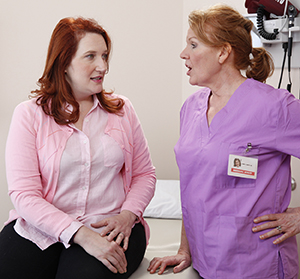Breast Health: Preventive Care
Breast self-awareness
Finding breast cancer early is the main goal of routine breast care. That's why it's so important to follow a plan for preventive care. Finding problems early gives you the best chance of successful treatment. Routine care can help find other noncancer (benign) conditions, too. Experts don’t all agree on the best breast cancer screening plan for women who are at average risk. Talk with a doctor about your breast cancer risk to decide on the best preventive care plan for you.

The American Cancer Society (ACS) says that all women should get to know how their breasts normally look and feel. Doing this can help you notice any changes more easily. Changes to your breasts may include:
-
Lumps.
-
Leaky fluid (discharge, including blood) other than breast milk.
-
Swelling, especially if it affects only one breast.
-
Skin redness or dimpling.
-
Nipple problems. This might be nipple pain, redness, or flaking. Or the nipple may turn inward.
See your doctor right away if you notice any of these changes.
The U.S. Preventive Services Task Force (USPSTF) and the ACS don't advise doing breast self-exams. This is because they may not lower the risk of dying from breast cancer. Talk with your doctor about whether you should do them.
Clinical breast exam (CBE)
Your routine physical exam might include a clinical breast exam (CBE) by a doctor or nurse trained to check breast problems. The American College of Obstetricians and Gynecologists (ACOG) advises:
-
Between ages 25 and 39, women should be offered a CBE by a doctor every 1 to 3 years.
-
After age 40, women should be offered a breast exam by a doctor every year.
But the USPSTF and ACS believe there isn't enough evidence to know if CBEs are helpful. Talk with your doctor to decide if you should have a CBE.
Mammogram
A mammogram is a low-dose X-ray of your breasts. A mammogram can find cancer or other problems early, before a lump can be felt. It can also help diagnose other breast problems. But a biopsy is needed to know for sure if you have cancer.
Health experts have different advice for breast cancer screening with mammograms:
-
The USPSTF advises screening every 2 years for women at average risk ages 40 to 74.
-
The ACS advises yearly screening for all women at average risk ages 45 to 54. Women ages 55 and older can change to mammograms every 2 years. Or they may choose to still have a yearly screening. Women between ages 40 and 44 have the choice to start screening with a mammogram every year.
-
ACOG advises women at average risk of breast cancer to have a screening mammography every 1 to 2 years starting at age 40 years. Screening should continue until at least age 75 years. After age 75, talk with your doctor.
Women at high risk for breast cancer may be advised to start breast cancer screening at a younger age and have an MRI in addition to a mammogram. For some women with dense breast tissue, ultrasound may be done in addition to a mammogram. Talk with your doctor about when to start getting mammograms and how often to have them.
Online Medical Reviewer:
Janet Campbell RN BSN
Online Medical Reviewer:
Jessica Gotwals RN BSN MPH
Online Medical Reviewer:
Tennille Dozier RN BSN RDMS
Date Last Reviewed:
6/1/2025
© 2000-2025 The StayWell Company, LLC. All rights reserved. This information is not intended as a substitute for professional medical care. Always follow your healthcare professional's instructions.